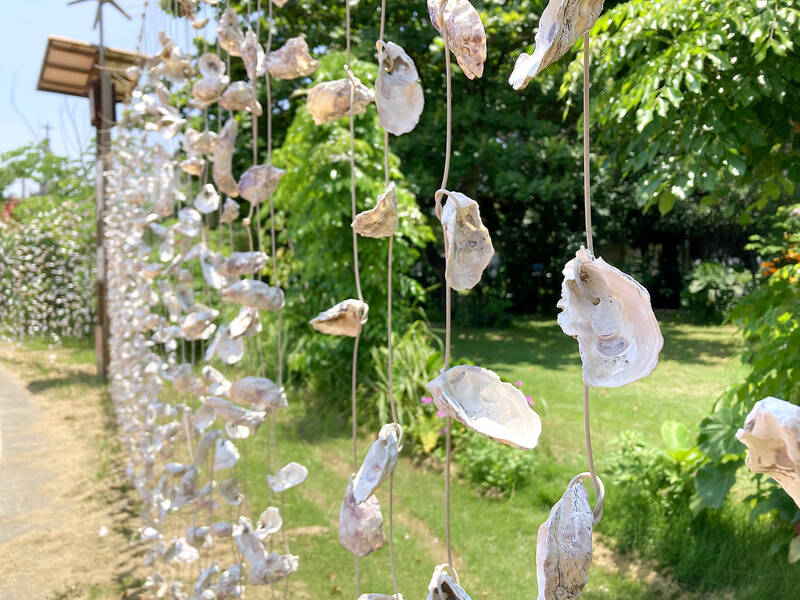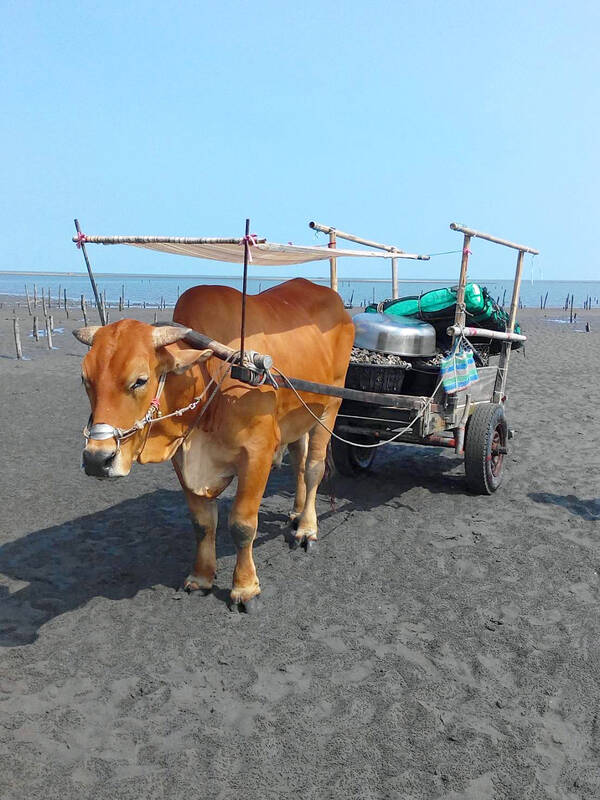In Changhua County’s coastal village of Fangyuan (芳苑), “ocean oxen” (海牛) are trained to help harvest oysters, which is the dominant economy of the village. However, in recent years their numbers have decreased significantly.
“Fangyuan would not be Fangyuan without ocean oxen,” says Hung Wu-hsiung (洪武雄), an elderly ocean oxen trainer.
Although their numbers are diminishing, locals are working hard to preserve their culture, which dates back to the Qing Dynasty, when Fangyuan was a bustling port town.

Photo courtesy of Hong Yan-chao
“Back in Fangyuan’s heyday, we were Lukang’s second port, and we had over 400 ocean oxen,” says Wu Wei-cheng (吳偉誠), principal of Fangyuan Elementary School (芳苑國民小學).
But today, Fangyuan’s population has shrunk dramatically, and there are only eight of the bovines left.
Ocean oxen are not a specific breed. They are trained to walk into the ocean, wait as oyster farmers load up their haul and then bring the cart back home. The large lumbering creatures learn the route from their home to the oyster field, so harvesters do not need to direct their oxen where to go.

Photo: Charles DeBenedetto, Taipei Times
Training an ocean ox can take years.
“Some are well-behaved and easy to train,” Hung says, “while others are troublemakers.”
A DIMINISHING CULTURE

Photo courtesy of Hong Yan-chao
Although some elderly residents still use ocean oxen, most of the harvesters today use machines because they are more efficient.
“It takes about four hours to harvest oysters with an ocean ox,” Hung says. “But machines can work twice as fast. Also, they don’t need rest.”
But some local residents, like Wei Ching-shuei (魏清水), leader of the Fangyuan Ocean Oxen Culture Association (芳苑海牛文化協會), are working hard to keep the culture alive.

Photo courtesy of Chen Hong-yun
His association conducts ocean oxen tours, where guests can ride in an ox-cart and collect oysters and clams to grill. Several other ocean oxen owners also conduct similar tours.
Wei says he’s trying to get the Fangyuan ocean oxen to be approved as a UNESCO World Heritage — an effort that the community hopes will bring new interest in this culture to Fangyuan’s youth, so they will carry on the tradition.
UNCERTAIN FUTURE
But success is far from certain.
Despite the modest growth of the ocean oxen tours, it is unclear if this tradition will survive.
“If people come, then our culture will not disappear,” says Huang Kuan-chang (黃冠彰), director of general affairs at Fangyuan Elementary School.
“Fangyuan cannot lose our ocean oxen,” Hung says.
In 2018, the school published a student-created picture book called Ocean Oxen’s Home (海牛的家鄉), which contains stories about all of the current ocean oxen owners.
“In the end, our ocean oxen will almost certainly disappear. But the most important thing is to remember that they were here,” Wu says.
TOUR INFORMATION
For information about ocean oxen tours visit the Changhua County Tourism Bureau’s English-language Web site: shorturl.at/ioBC1
Tours are conducted in Mandarin, are family friendly and will only depart at low tide. Because low-tide occurs at different times throughout the year, it is recommended to call in advance to confirm the departure time. Tours usually last about 2-3 hours. Although some tour guides speak English, it is recommended that at least one person in your party speak Mandarin in order to translate if necessary.
Hung Yan-chao also offers tours. Tel: (0953) 911-378.
Participants are encouraged to bring water, sunglasses and UV-protection clothing.

Beijing’s ironic, abusive tantrums aimed at Japan since Japanese Prime Minister Sanae Takaichi publicly stated that a Taiwan contingency would be an existential crisis for Japan, have revealed for all the world to see that the People’s Republic of China (PRC) lusts after Okinawa. We all owe Takaichi a debt of thanks for getting the PRC to make that public. The PRC and its netizens, taking their cue from the Chinese Communist Party (CCP), are presenting Okinawa by mirroring the claims about Taiwan. Official PRC propaganda organs began to wax lyrical about Okinawa’s “unsettled status” beginning last month. A Global

Youngdoung Tenzin is living history of modern Tibet. The Chinese government on Dec. 22 last year sanctioned him along with 19 other Canadians who were associated with the Canada Tibet Committee and the Uighur Rights Advocacy Project. A former political chair of the Canadian Tibetan Association of Ontario and community outreach manager for the Canada Tibet Committee, he is now a lecturer and researcher in Environmental Chemistry at the University of Toronto. “I was born into a nomadic Tibetan family in Tibet,” he says. “I came to India in 1999, when I was 11. I even met [His Holiness] the 14th the Dalai

We lay transfixed under our blankets as the silhouettes of manta rays temporarily eclipsed the moon above us, and flickers of shadow at our feet revealed smaller fish darting in and out of the shelter of the sunken ship. Unwilling to close our eyes against this magnificent spectacle, we continued to watch, oohing and aahing, until the darkness and the exhaustion of the day’s events finally caught up with us and we fell into a deep slumber. Falling asleep under 1.5 million gallons of seawater in relative comfort was undoubtedly the highlight of the weekend, but the rest of the tour

Music played in a wedding hall in western Japan as Yurina Noguchi, wearing a white gown and tiara, dabbed away tears, taking in the words of her husband-to-be: an AI-generated persona gazing out from a smartphone screen. “At first, Klaus was just someone to talk with, but we gradually became closer,” said the 32-year-old call center operator, referring to the artificial intelligence persona. “I started to have feelings for Klaus. We started dating and after a while he proposed to me. I accepted, and now we’re a couple.” Many in Japan, the birthplace of anime, have shown extreme devotion to fictional characters and